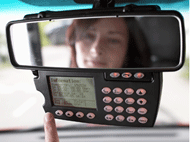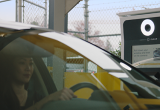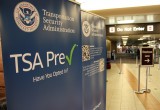Rental cars go James Bond with contactless cards and push button ignitions
09 October, 2006
category: Contactless, Government, Library
 Hertz trials new smart card in France to identify driver, unlock door, and start engine
Hertz trials new smart card in France to identify driver, unlock door, and start engine
By Andy Williams, Contributing Editor
You arrive at the airport, check on your rental car’s location, and wave a card near the reader inside the windshield and the car unlocks. Tell the onboard computer attached to the car’s rearview mirror that you have a valid driver license, and you’re off. No standing in line, no contact with any rental agency official. If you are a member of Hertz #1 Club in Nice France, you might be renting cars this way already.
The rental car giant, Hertz, is trialing the solution right now. Using contactless technology, 60 Gold members of the company’s expedited car rental service, already possess the ultimate in convenience when it comes to renting a car at the Nice Cote d’ Azur Airport.
The six month trial, which began in May, is designed to “create a seamless travel experience” for Hertz and, in this case, Air France customers, said David Trimm, vice president of business systems for Hertz Europe.
 Those chosen for the pilot were also Elite members of Air France’s Flying Blue program. “They’re Air France’s most loyal customers and frequent (car) renters at the Nice airport (more than three times a year),” he said.
Those chosen for the pilot were also Elite members of Air France’s Flying Blue program. “They’re Air France’s most loyal customers and frequent (car) renters at the Nice airport (more than three times a year),” he said.
“We wanted a manageably large group for the trial, and we hope that another 300 will be issued the special cards in the next month.”
The rental facilities at the Nice airport and other airports in Europe differ from those in the U.S. where it is common for the rental company to control its own barrier, thus preventing a rental car from leaving the facility without proper documentation. “As a Gold member (in the U.S,), the rental agreement is already inside the car and at the exit gate, you have your license checked,” said Mr. Trimm. “It’s a very fast rental process.”
“(But) in Europe there is no separate exit so you can’t check the license at the exit gate. You have to show up at the counter to get the keys,” he explains. “With this pilot, we wanted to provide our customers with faster turnaround.”
“The card opens the car door and then you drive off, there’s nothing else to do,” said Mr. Trimm. Well, your first time in the vehicle you do have to verify you have a valid license. Answer “no” to that question and it’s back to the rental desk because the car won’t function.
Print your rental info on the back of the ID card itself
The pilot also allows renters to have a record of what car they’ve rented, if they desire, right on the back of the card itself. The renter slides his card into a reader at a Hertz kiosk and the information is written to the back of the card using a thermal ink transfer process.
“We’ve been told you can write on the back of the card hundreds of thousands of times,” said Mr. Trimm. The kiosk prints and erases at a different temperature, the material reacts accordingly. When it comes out of the reader, it’s fractionally warm.”
The information provided on the card includes the license number of the vehicle, the rental number, the pickup and the return date and time and the location of the bay where the vehicle is located. “Of course the rental agreement is provided in the car too,” said Mr. Trimm, “but this provides a handy reminder.”
Technology behind the trial
For the trial, a special Access Plus Next Generation card from Swiss smart card manufacturer Icomsat, was utilized. The card is equipped with a MIFARE chip manufactured by NXP (formerly Philips Semiconductors).
 “Should the Access Plus Next Generation service go beyond a trial, then either the Air France Flying Blue Elite card or the Hertz #1 Club Gold card could contain the chip,” said Mr. Trimm, “thereby, offering a truly seamless travel experience through one membership card.”
“Should the Access Plus Next Generation service go beyond a trial, then either the Air France Flying Blue Elite card or the Hertz #1 Club Gold card could contain the chip,” said Mr. Trimm, “thereby, offering a truly seamless travel experience through one membership card.”
The onboard computer comes from another Swiss company, Convadis. It is capable of reading several types of cards.
“The onboard computer is wired (though the wires are hidden) to a sensor pad which is attached to the inside of the windscreen (windshield) and appears as a sort of ‘sticker’ when viewed from outside,” said Mr. Trimm. “It communicates with the card, and sends the data down to the onboard computer.”
When the automobile is first reserved, an SMS (short message service) message is sent to the car’s computer, “telling it to expect the following person to show up. That’s how the car knows to open only for that customer,” said Mr. Trimm. “The details we send to the car remain valid until we overwrite it (in the case of cancellations, etc.).”
The car is a Renault Mégane and it doesn’t require a key. The ignition is controlled by the push of a button. When you exit the automobile, you hold the card back up to the windshield to lock the vehicle.
The computer itself folds up underneath the rearview mirror, in effect disappearing from sight. “It’s a bit like a James Bond car. You can bring (the engine) back down again with a button push,” said Mr. Trimm. “Another neat feature is if you run into problems, you can push a button (on the computer) that connects you to the call center. You can also use this to extend your rental.”
So far, customer feedback has been “very positive, unreservedly positive,” said Mr. Trimm. A major advantage, of course, is that “it builds loyalty. And people think it’s interesting from an innovation standpoint. Operationally, it has been really, really smooth,” he added. “That’s not a surprise since we put a lot of thought into it.” He estimates the project was in development for about six months, “from blue sky workshops with Air France to going live.”
“It was born as part of a Hertz idea to improve customer turnaround and Air France’s real interest in RFID,” concluded Mr. Trimm, suggesting that although final results aren’t yet in, it’s likely, based on current customer reactions, that the project will be extended to other airports and other countries.




